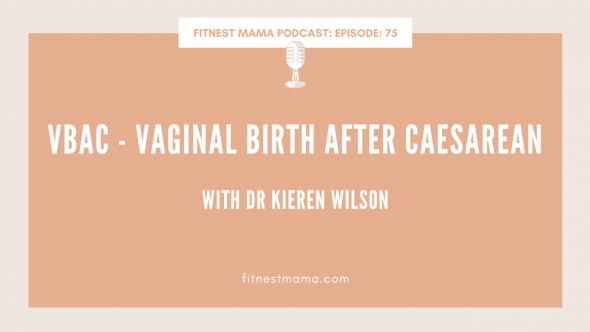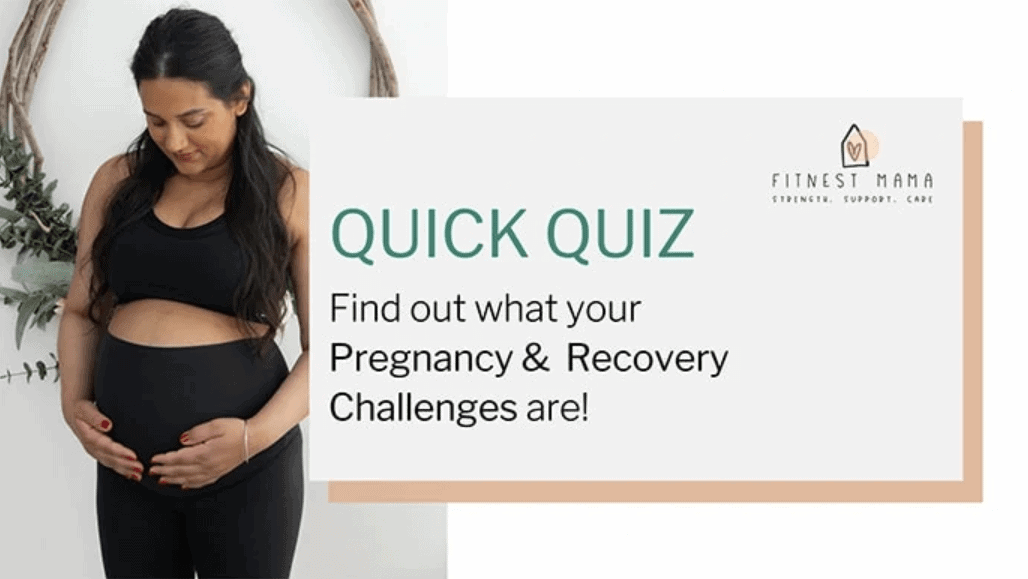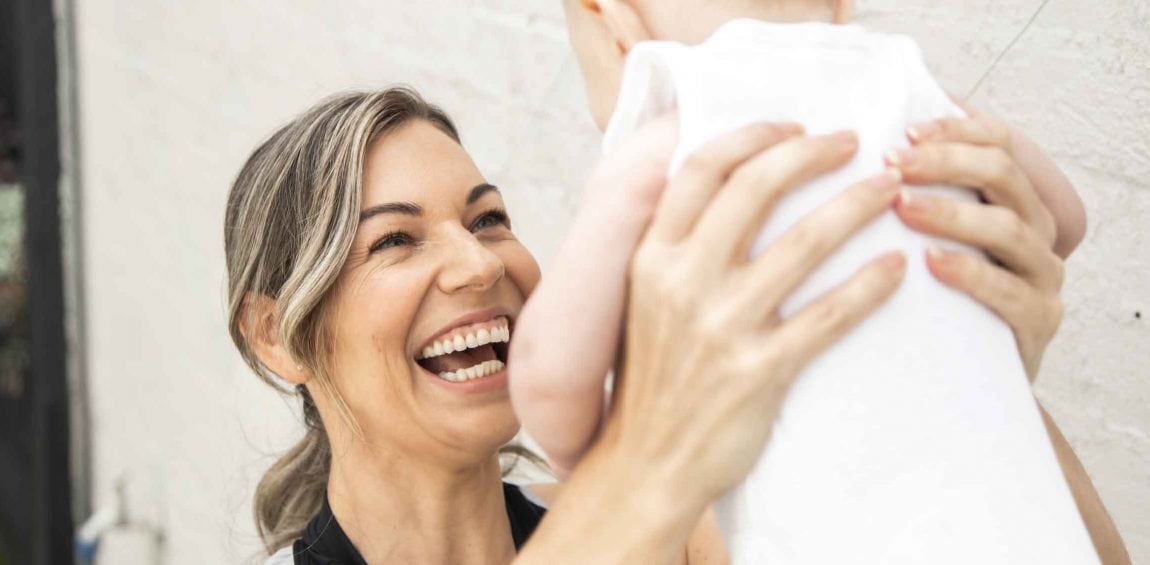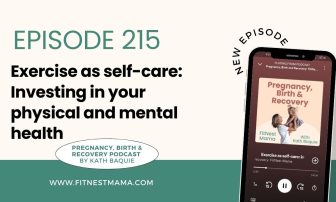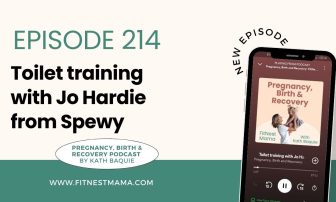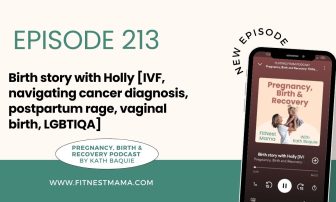Please note that this transcription was completed with computer voice recognition software. Quite often unanticipated grammatical, syntax, homophones, and other interpretive errors are inadvertently transcribed by the computer software. Please disregard these errors. Please excuse any errors that have escaped final proofreading.
If you are pregnant or you’ve recently had a baby, this podcast is for you. I am your host Kath Baquie. A physiotherapist working in women’s health and mum of three. Join me each week as we dive into all things pregnancy care, childbirth, and postnatal recovery, helping you have a wonderful pregnancy and afterbirth experience. And don’t forget to hit subscribe so you don’t miss any episodes.
Well, hello there. It’s great to have you here for another episode of the FitNest Mama Podcast. In this episode today, I am fortunate to be talking to obstetrician and gynecologist Dr. Kieren Wilson, all about Vaginal Birth After Cesarean section, which is also known as VBAC. So Dr. Kieren Wilson is an obstetrician gynecologist based in Sydney, Australia. And after completing his medical studies, he has trained and worked in various hospitals in Sydney before spending time gaining further specialty experience overseas. Dr. Kieren Wilson now dedicates his time to offering the best possible level of care to women in his private obstetrics and gynecology practice with consulting rooms in both the Marta and on Bridge Street in Sydney CBD.
So in this episode, we are talking about what is a vaginal birth after cesarean. So what is a VBAC? We talk about why some women opt for a VBAC. And when a VBAC might not be possible, so in what scenarios might not be possible. And then we run through the risks and benefits of a VBAC. And Dr. Kierin Wilson talks about how successful they are generally and also having some tips for women who are wishing to consider this. So I trust you’re going to find it a really valuable episode, and you’ll feel more empowered and confident in this decision for you to then have a further chat with your health care provider about whether or not this might be an option for you.
So before we dive into this episode, I do invite you to the free Pregnancy Workshop that is available and this is all about preparing your pelvic floor for birth and beyond. So in this Pregnancy Workshop, we discuss ways to help prepare your pelvic floor for birth and beyond. And that includes things like perineal massage, and we also talk about how to boost your after birth recovery in those early days and weeks postpartum. So if you are pregnant, do check it out. Just head to fitnestmama.com/free.
Right. Let’s get into this episode with Dr. Kieren Wilson all about a VBAC.
So thank you so much for joining me today on the podcast, Dr. Kieren Wilson. I really do appreciate having this opportunity to chat all things, VBAC.
DR. KIEREN WILSON
Thank you very much. I’m always happy to help out ladies who are pregnant or planning a pregnancy in the future and discuss any topics that come up from time to time. Absolutely.
KATH BAQUIE
It’s great to have this opportunity to chat. So can you please just define what is a VBAC? Let’s just go straight to basic so we’re on the same page.
DR. KIEREN WILSON
So I’m like, what the VBAC stands for is Vaginal Birth After Cesarean. So that means that the woman has had one of her babies delivered by caesarean in the past and on subsequent pregnancy, then she’s very interested in having a normal birth for the next baby.
KATH BAQUIE
And why do some women want to have a VBAC? Why do some women opt for this?
DR. KIEREN WILSON
It’s quite personal, really, so some women have always thought that they would like to, to have a normal birth, that’s something that they thought about over many years, often, and they will just decide that’s the way that they want to have their baby. You know, they’re fully aware that there’s always the option for cesarean but it’s one of those experiences that they want to have. And that often motivates the majority of women who I’ve seen to go down that path, and that’s where we sort of start from there. Yeah.
KATH BAQUIE
And do you find it’s generally women who’ve had an emergency cesarean birth in the past?
DR. KIEREN WILSON
About half and half really, like for example, the first baby may have been a breech presentation, which has led to the elective cesarean or they’ve been overseas and in other countries and had their baby by cesarean, but because we always bring it up about how women would like to have had the baby and if they had the cesarean before, that we always talk about VBAC. And so there’s those other women who decided that they would like to have a normal birth that way. Yeah, so it’s not always like an emergency situation that leads to a VBAC. It’s about 30% of cesareans happened under emergency conditions. And there’s other ones that have like elective procedures for various different reasons.
KATH BAQUIE
Amazing. So I would love to chat about, I guess, the pros and the cons. So what are the benefits? What are the risks of VBAC? But before we do get into that, when might a VBAC not be possible? So are there any situations where a woman might find it’s just not a possible scenario?
DR. KIEREN WILSON
Of course, yeah, so the big one would be if the previous caesarean has been what’s called the classical cesarean. And that means that the incision on the uterus is a vertical incision. It’s not sideways or transverse. And so if that’s happened, then you know, we can’t offer a VBAC in that situation. And sometimes we see like a classical cesarean being done for if the baby was preterm like 25 weeks, or might be 26 weeks, if there’s been a reason to deliver the baby that early. Sometimes we have to make that kind of incision. And that would mean that every other pregnancy needs to be delivered by a cesarean, after that’s happened. So that’s the big one. And then if a woman has had two cesareans in the past, then it’s much safer to continue having cesareans after that. But if they’ve only had one cesearean before, then, yes, VBAC is very possible. But after two caesareans, no. It’s increasing then other complications, we would stay away from them.
KATH BAQUIE
And what complications might they include?
DR. KIEREN WILSON
So the big one that we worry about is like uterine rupture. And that’s, you know, when the old scar opens before the baby’s been born, and that happens because of the contractions that are happening. And it puts pressure on that scar and it can open and that’s called a uterine rupture. If that happens, then neither the baby can become acutely distressed, the mother can lose a lot of blood very quickly. And that will lead to an emergency cesarean section under emergency conditions, meaning a general anaesthetic straightaway, because we need to manage that situation very, very quickly.
KATH BAQUIE
And do you know any stats or what are the chances of a uterine rupture occurring in a VBAC after one previous cesarean versus two?
DR. KIEREN WILSON
So we go by the Royal Australian College of Obstetrician Gynecologist, they have a very nice guideline, which outlines the risks. We normally quote, somewhere between about five to seven per 1000 VBACs will have a rupture. So that’s very low, even in like medical terms at a very low risk, and that’s why we offere it.
KATH BAQUIE
Okay, so that’s after one cesarean.
DR. KIEREN WILSON
Yeah. And then after two, it’s a bit harder to sort of quantify because, you know, hasn’t really been studied that well. That would be like a very difficult started to undertake to get good numbers on that. But it would be a lot higher. Yeah, it would be, but we can’t give an exact figure like after one because it just hasn’t been studied properly.
KATH BAQUIE
Have you done many VBAC after two cesareans?
DR. KIEREN WILSON
A couple, yeah. Because it’s always the, you know, the woman’s choice, like everybody has the right to their own healthcare and the way that they would like things to be done. And I had seen it happen specially when I worked in the UK. There were women there who had a vaginal delivery after two previous cesareans, and it went well. But those women were just fresh, highly motivated to try and meet had extensive discussions about the risks and what would happen if we detected any complications. And when we would need to stop.
KATH BAQUIE
Is there anything that a woman can do to help improve her chances of a successful VBAC?
DR. KIEREN WILSON
There’s a couple of things they could do. So you could have the baby around the due date and not go too far over. But do your best if possible to make sure that the baby’s not too big. And then when you’re in labour having a VBAC you want to be moving around in positions to help the baby come down and help those contractions happen to have that birth but during the pregnancy itself, like it’s very difficult to do things that can increase your chance of having a successful vaginal birth after cesarean, mainly because like the antenatal care and then the labour itself are two very different things. Although we do lots of things antenatally to help women have a normal birth. For a VBAC. There’s not a lot that people can do. You can only really sort of try on the day, and then see how things go. And be in that sort of, like constant monitoring and assessing environment just to make sure that everything’s progressing well and being safe.
KATH BAQUIE
Okay, so going back, did you feel you discussed all the risks? So we talked about uterine rupture? Were there any other risks you wanted to mention associated with VBAC?
DR. KIEREN WILSON
That’s the main one of having a VBAC. So uterine rupture, blood loss, you know, the risks of emergency surgery under emergency conditions. And then there’s also the risk of the baby as well that, you know, if in the event, there was a complication that could affect the baby, and you know, like, sometimes a baby would need to go to the special care nursery if it had breathing difficulties, or if it had lost any blood during the delivery, that they’re the main ones that we would definitely discuss we bring up various different points during the pregnancy itself.
KATH BAQUIE
Yeah. Okay. And so with those risks, is there any extra monitoring that might occur with a woman who’s having a VBAC versus another woman who’s giving birth at the same time?
DR. KIEREN WILSON
So the big one every hospital in Australia has a policy on how to care for a woman who’s having a vaginal birth after cesarean in labour. So the big one is having continuous fetal monitoring. So that’s the CTG machine. And there are those two probes that sit on the mother’s tummy and they monitor the baby’s heart rate. And they also check the contractions. So it’s good these days, because they’re often ones that are cordless. So it’d be like sort of Wi Fi really, and they allow the women to walk around inside the labour rooms. So they’re still mobile as well. But we also need to have like a cannula like a drip in. So we have IV access if there is an emergency situation, and then we need to make sure that the labour is progressing well. So that means that they will be examinations of the cervix to make sure that it’s opening and that the woman is progressing in labour. As we would expect, we would like to see the cervix opening at about one centimetre per hour. And then when she gets to full dilatation, so the cervix being open at 10 centimetres. So she’s pushing for no more than about one hour, because they help to reduce the risk of any complications. And the big one being the uterine rupture, of course, yeah.
KATH BAQUIE
Yeah. Okay, that’s good to know. So we’ve talked quite a lot about the risks associated with VBAC and when it might not be possible. Let’s go into the beautiful benefits now that a woman might experience by having a VBAC. And I know, these are probably very personal. But from your perspective, what do you see as any benefits with VBACs?
DR. KIEREN WILSON
Oh, so you know, avoid all of those emergency situations. You avoid major surgery. You can walk around while you’re having the baby, basically, having a normal birth, there’s less pain associated with that, of course, they’re the big ones in you know, trying for a normal birth after a caesarean because you there’s less care that you have to look after. But we do like to keep women in hospital for at least a day or so afterwards, because there is, you know, just to make sure that the uterus is contracting back down. And sometimes those ruptures can occur after the baby comes out as well. So we need to keep a close eye on make sure that’s not happening.
KATH BAQUIE
Yeah. Okay. I didn’t realize that I just assumed it would all happen during birth. So you’d like to monitor it for a couple of extra days?
DR. KIEREN WILSON
Yeah, yes, up to about three. Now, if that eruptions going to happen, it’s normally within the first 24 hours after the babies come out. So it’s best to be in hospital where you can get help if that does happen.
KATH BAQUIE
And how might a woman know if a rupture has occurred?
DR. KIEREN WILSON
So the biggest one is going to be the pain. So if you haven’t got an epidural in that there’s going to be that severe pain associated with that rupture. If there is an epidural in then we can see the baby becoming distressed on the monitoring, and that will alert the doctors and midwives to the fact that you know, this could be a rupture. But then the next big one would be that there’s heavy vaginal bleeding. And that means that the rupture has opened and the blood is basically coming out. So they’re the big early signs that the rupture has started or in fact, it’s a faulty construction, that baby needs to be delivered immediately.
KATH BAQUIE
Now, you mentioned the classical cesarean birth earlier and have if you’ve had a classical cesarean then you won’t be able to have a VBAC as an option. Did classical cesareans used to be a lot more common than they are now?
DR. KIEREN WILSON
Yeah, so they were. But that was a long time ago that it’d be well over 30 to 40 years ago, when that was routine. And then it became obvious that we don’t need to do that for all the cesareans and we can do the lower transverse incision, and that’s much safer. Yeah.
KATH BAQUIE
You mentioned it has to be classical if it’s a preterm baby, but under the 25 weeks?
DR. KIEREN WILSON
Yeah. So in a preterm, there’s no what we call the lower segment, which is like the lower portion of the uterus, that starts to form anywhere between like 24 to, to like 26 weeks. So if that’s not there, then you can’t make that incision because it doesn’t exist. And the only option that you’ve got is to make a vertical incision on the uterus.
KATH BAQUIE
Yeah. Okay, that makes sense. Thanks for clearing that up. Okay, so to wrap this up, do you have any words of wisdom if there’s a pregnant woman listening today, and she’s thinking, you know, this resonates with me, I’d like to perhaps find out more about this. What information can you impart? What words of wisdom do you have for a pregnant woman listening?
DR. KIEREN WILSON
Yeah, so yeah, I know, we’ve gone into a lot into the risks and when you can’t do it, but putting all that aside, you know, we always say that in the right situations that there’s up to about 60 to 80% chance of being successful. So that’s why we think that people should try to see if they want to. So if they wanted to, you know, always have a chat to their doctor, then the midwife. And to do it safely, that there’s certain things they can do during their pregnancy. So they can do some, some ultrasounds and make sure the baby’s not too big, they can have the baby around 40 weeks or no more than 41 weeks, and that will improve the chance of success. And then, but just be aware of the you know, that the monitoring that the hospital will essentially want by these women to have.
KATH BAQUIE
And I think you brought up a great point before we have talked a lot about the risks and I guess a scary side of the VBACs. But like as you said 60 to 80% of them are successful. It sounds like there’s a lot of monitoring that occurs during so the actual risks, would you agree? They’re really small for mum and bubs? Because of all the monitoring that occurs?
DR. KIEREN WILSON
Yeah. So we do it very safely, of course. But you know, at the end of the day, we want healthy lamb and healthy baby. And that’s why we do all this pre pregnancy counselling and antenatal care and intrapartum care is absolutely critical to ensure that that safety continues. And that’s why we have all those extra monitoring and yeah, want to be on a labour ward in a bigger hospital that has access to operating theatres if we need to. And I would always say to those mums that are interested in doing it, well, I think about it, and yeah, and if it’s something that you want to do, then go for it, because lots of women do these days, and, and we have good data to support that is safe and under the right conditions. And, and the success rate is good, but it is a very individual thing. So you know, like we’ve talked about before you’ve had two previous cesareans, or a classical or the babies too big or if you’ve gone over your due dates a bit, then it might not be the safest way for you to proceed. And that might be an elective cesarean is the way to go.
KATH BAQUIE
Yeah, great. And as always, this is all general information only. So I’m sure every pregnant woman listening will go and have a chat with their healthcare provider to discuss the pros and cons for this specific situation. And on that note, Dr. Wilson, where can women find you if they want to come and see you perhaps or come and see where you work?
DR. KIEREN WILSON
Yeah, sure. So I’m based in Sydney and I have a very comprehensive website, www.drkieranwilson.com.au. Also got my Instagram page going as well, which is @drkieranwilson. All one word. Which is, you know, a work in progress, of course. So that’s always there.
KATH BAQUIE
You’re new to the Instagram world. How are you finding it?
DR. KIEREN WILSON
Oh it was good. Yeah, no, it’s good. That’s a good option, too good way to get information out to people and for people to contact as well. So yeah, there is a post there about VBACS as well, which people can have looking at any time they like. But more than happy to be contacted through the website or it’s really Instagram. If there’s any other questions.
KATH BAQUIE
Yeah. And come and send us a message and let us know if you’ve listened to this podcast episode and what you thought. So thank you so much, Dr. Wilson for coming on and sharing your thoughts and expertise with us today. Really do appreciate it.
DR. KIEREN WILSON
That’s my pleasure.
KATH BAQUIE
We’ll chat to you soon.
So before I sign off, remember my team and I will be putting together the show notes for this episode. With all the links including how to connect with Dr. Kieren Wilson at fitnestmama.com/podcast and don’t forget to send Dr. Wilson and myself a DM on Instagram. We would love to hear from you. Have a fabulous day everyone and I look forward to you joining me soon for another episode of the FitNest Mama Podcast.
Thanks for listening to the FitNest Mama Podcast brought to you by the FitNest Mama Freebies found at www.fitnestmama.com/free. So please take a few seconds to leave a review, subscribe, so you don’t miss an episode. And be sure to take a screenshot of this podcast, upload it to your social media and tag me, @fitnestmama, so I can give you a shout out too. Until next time! Remember, an active pregnancy, confident childbirth, and strong postnatal recovery is something that you deserve. Remember, our disclaimer, materials, and contents in this podcast are intended as general information only and shouldn’t substitute any medical advice, diagnosis, or treatment. I’ll see you soon!
